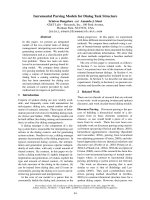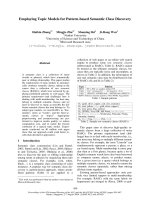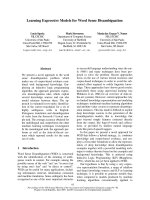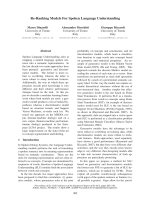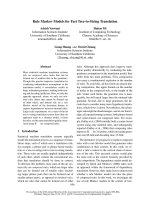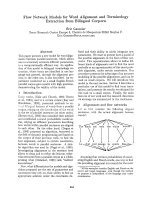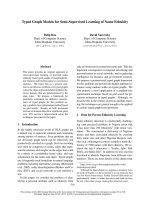Báo cáo sinh học: " Factor analysis models for structuring covariance matrices of additive genetic effects: a Bayesian implementation" ppsx
Bạn đang xem bản rút gọn của tài liệu. Xem và tải ngay bản đầy đủ của tài liệu tại đây (111.05 KB, 14 trang )
Genet. Sel. Evol. 39 (2007) 481–494 Available online at:
c
INRA, EDP Sciences, 2007 www.gse-journal.org
DOI: 10.1051/gse:20070016
Original article
Fa ctor analysis models for structuring
covariance matrices of additive genetic
effects: a Bayesian implementation
Gustavo de los C
a∗
,DanielG
a,b,c
a
Department of Animal Sciences, University of Wisconsin-Madison, WI 53706, USA
b
Department of Dairy Science and Department of Biostatistics and Medical Informatics,
University of Wisconsin-Madison, WI 53706, USA
c
Department of Animal and Aquacultural Sciences, Norwegian University of Life Sciences,
1432 Ås, Norway
(Received 5 January 2006; accepted 28 March 2007)
Abstract – Multivariate linear models are increasingly important in quantitative genetics.
In high dimensional specifications, factor analysis (FA) may provide an avenue for struc-
turing (co)variance matrices, thus reducing the number of parameters needed for describing
(co)dispersion. We describe how FA can be used to model genetic effects in the context of
a multivariate linear mixed model. An orthogonal common factor structure is used to model
genetic effects under Gaussian assumption, so that the marginal likelihood is multivariate nor-
mal with a structured genetic (co)variance matrix. Under standard prior assumptions, all fully
conditional distributions have closed form, and samples from the joint posterior distribution
can be obtained via Gibbs sampling. The model and the algorithm developed for its Bayesian
implementation were used to describe five repeated records of milk yield in dairy cattle, and
a one common FA model was compared with a standard multiple trait model. The Bayesian
Information Criterion favored the FA model.
factor analysis / mixed model / (co)variance structures
1. INTRODUCTION
Multivariate mixed models are used in quantitative genetics to describe, for
example, several traits measured on an individual [6–8], or a longitudinal se-
ries of measurements of a trait, e.g., [23], or observations on the same trait
in different environments [19]. A natural question is whether multivariate ob-
servations should be regarded as different traits or as repeated measures of
the same response variable. The answer is provided by a formal model com-
parison. However, it is common to model each measure as a different trait,
∗
Corresponding author:
Article published by EDP Sciences and available at
or />482 G. de los Campos, D. Gianola
leading to a fairly large number of estimates of genetic correlations [7, 8, 19].
A justification for this is that the multiple-trait model is a more general speci-
fication, with the repeated measures (repeatability) model being a special case.
However, individual genetic correlations differing from unity is not a sufficient
condition for considering each measure as a different trait. While none of the
genetic correlations may be equal to one, the vector of additive genetic values
may be approximated reasonably well by a linear combination of a smaller
number of random variables, or common factors.
Another approach to multiple-trait analysis is to redefine the original
records, so as to reduce dimension. For example, [25] suggested collapsing
records on several diseases into simpler binary responses (e.g., “metabolic dis-
eases”, “reproductive diseases”, “diseases in early lactation”). Likewise, for
continuous characters, one may construct composite functions that are linear
combinations of original traits. However, when records are collapsed into com-
posites, some of the information provided by the data is lost. For instance, con-
sider traits X and Y.IfX + Y is analyzed as a single trait, information on the
(co)variance between X and Y is lost.
Somewhere in between, is the procedure of using a multivariate technique
such as principal components or factor analysis (PCA and FA, respectively),
for either reducing the dimension of the vector of genetic effects (PCA) or
for obtaining a more parsimonious model without reducing dimension (FA).
Early uses of FA described multivariate phenotypes, e.g., [21, 24]. PCA and
FA have been used in quantitative genetics [1, 3, 5, 11], and most applications
consist of two steps. One approach, e.g., [3], consists of reducing the number
of traits first, followed by fitting a quantitative genetic model to some com-
mon factors or principal components. In the first step, a transformation matrix
(matrix of loadings) is obtained either by fitting a FA model to phenotypic
records or by decomposing an estimate of the phenotypic (co)variance matrix
into principal components. These loadings are used to transform the original
records to a lower dimension. In the second step, a quantitative genetic model
is fitted to the transformed data. Another approach fits a multiple trait model
in the first step [1, 11], leading to an estimate of the genetic (co)variance ma-
trix, with each measure treated as a different trait. In the second step, PCA
or FA is performed on the estimated genetic (co)variance matrix. However,
as discussed by Kirkpatrick and Meyer [10] and Meyer and Kirkpatrick [15],
two-step approaches have weaknesses, and it is theoretically more appealing
to fit the model to the data in a single step.
This article discusses the use of FA as a way of modeling genetic effects.
The paper is organized as follows: first, a multivariate mixed model with an
Factor analysis of random effects 483
embedded FA structure is presented, and all fully conditional distributions re-
quired for a Bayesian implementation via Gibbs sampling are derived. Subse-
quently, an application involving a data set on cows with five repeated records
of milk yield each is presented, to illustrate the concept. Finally, a discussion
of possible extensions of the model is given in the concluding section.
2. A COMMON FACTOR MODEL FOR CORRELATED
GENETIC EFFECTS
In a standard FA model, a vector of random variables (u) is described as
a linear combination of fewer unobservable random variables called common
factors (f), e.g., [12,13,16]. The model equation for the i
th
subject when q com-
mon factors are considered for modeling the p observed variables can be writ-
ten as,
u
1i
.
.
.
u
pi
=
λ
11
λ
1q
.
λ
p1
λ
pq
f
1i
.
.
.
f
qi
+
δ
1i
.
.
.
δ
pi
,
or, in compact notation,
u
i
= Λf
i
+ δ
i
. (1)
Above, u
i
=
u
1i
, , u
pi
; Λ =
λ
jk
is the p × q matrix of factor loadings;
f
i
=
f
1i
, , f
qi
is the q × 1 vector of common factors peculiar to individual i,
and δ
i
=
δ
1i
, , δ
pi
is a vector of trait-specific factors peculiar to i.From(1)
the equation for the entire data can be written as,
u =
(
I
n
⊗ Λ
)
f + δ, (2)
where u = (u
1
, , u
n
), f = (f
1
, , f
n
), and δ = (δ
1
, , δ
n
).
Equation (1) can be seen as a multivariate multiple regression model where
both the random factor scores and the incidence matrix (Λ) are unobserv-
able. Because of this, the standard assumption required for identification in
the linear model, i.e., δ
i
⊥ f
i
, is not enough. To see that, following [16], let
H be any non-singular matrix of appropriate order, and form the expression
Λf = ΛAHH
−1
f = Λ
∗
f
∗
,whereΛ
∗
= ΛH and f
∗
= H
−1
f. This implies that (1)
can also be written as u
i
= Λ
∗
f
∗
i
+ δ
i
so that neither Λ
∗
nor f
∗
are unique. In
the orthogonal factor model this identification problem is solved by assuming
that common factors are mutually uncorrelated. However, even with this as-
sumption, factors are determined up to an orthonormal transformation only. To
484 G. de los Campos, D. Gianola
verify this, following [16], let T be an orthonormal matrix such that T
T = I.
Then, from (1), Cov
(
u
i
)
= Σ
u
= ΛΛ
+ Ψ = ΛT
TΛ
+ Ψ = Λ
∗
Λ
∗
+ Ψ,
where Ψ = Cov
(
δ
i
)
and Λ
∗
= ΛT
. This means that, to attain identification,
factor loadings need to be rotated in an arbitrary q-dimensional direction. The
restrictions discussed above are arbitrary and not based on substantive knowl-
edge; because of this, the method is particularly useful for exploratory analy-
sis [9, 12, 13].
In addition to the restrictions described above, maximum likelihood or
Bayesian inference necessitate distributional assumptions. The standard prob-
ability assumption for a Gaussian model with orthogonal factors is
f
i
δ
i
iid
∼
N
0
0
,
I
q
0
0 Ψ
,
(3)
where “iid” stands for “independent and identically distributed”, and Ψ,of
order p × p, is assumed to be a diagonal matrix. Combining (1) and (3), the
marginal distribution of u
i
is,
u
i
iid
∼
N
0, ΛΛ
+ Ψ
. (4)
Consider now a standard multivariate additive genetic model for p traits mea-
sured on each of n subjects
y
i
= X
i
β + Z
i
u
i
+ ε
i
,
where y
i
=
y
i1
, , y
ip
,isap×1 vector of phenotypic measures taken on sub-
ject i (i = 1, , n); β and u
f
are unknown vectors of regression coefficients and
of additive genetic effects, respectively; X
i
and Z
i
are known incidence matri-
ces of appropriate order, and ε
i
is a p × 1 vector of model residuals. Stacking
the records of the n subjects, the equation for the entire data set is,
y = Xβ + Zu + ε, (5)
where y = (y
1
, , y
n
)
, X = (X
1
, , X
n
)
, Z = Diag {Z
i
}, u =
(
u
1
, , u
n
)
,and
ε = (ε
1
, , ε
n
)
. A standard probability assumption in quantitative genetics is,
ε
u
∼ N
0,
I
n
⊗ R
0
0
0A
n
⊗ G
0
,
(6)
where R
0
and G
0
are each p × p (co)variance matrices of model residuals and
of additive genetic effects, respectively, and A is the n × n additive relationship
matrix.
Factor analysis of random effects 485
Assume now that (2) holds for the vector of additive genetic effects in (5)
so that
y = Xβ + Z
(
I
n
⊗ Λ
)
f + Zδ + ε, (7)
where Λ is as before, and f and δ are interpreted as vectors of common and
specific additive genetic effects, respectively. Combining the assumptions of
the orthogonal FA model described above with those of the additive genetic
model leads to the joint distribution
ε
f
δ
∼ N
0,
I
n
⊗ R
0
00
0A
n
⊗ I
q
0
00A
n
⊗ Ψ
,
(8)
where Ψ (p × p) is the (co)variance matrix of specific additive genetic effects,
assumed to be diagonal, a stated earlier. Note that in (8), unlike in the standard
FA model, i.e.,(3),different levels of common and specific factors are cor-
related due to genetic relationships. With these assumptions, the conditional
distribution of the data, given β, u and R
0
is
y|u, β, R
0
∼ N
Xβ + Zu, I ⊗ R
0
. (9a)
Alternatively, using (2), one can write
y|u, β, R
0
= y|f, δ, Λ, β, R
0
∼ N
Xβ + Z
(
I
n
⊗ Λ
)
f + Zδ, I ⊗ R
0
. (9b)
2.1. Bayesian analysis and implementation
In a multivariate linear mixed model, a Bayesian implementation can be
entirely based on Gibbs sampling because, under standard prior assumptions,
the fully conditional posterior distributions of all unknowns have closed form,
e.g., [20]. It turns out that in the model defined by (7) and (8), and under
prior assumptions to be described below, all fully conditional distributions
have closed form, and a Bayesian analysis can be based on a Gibbs sampler as
well. Next, the prior assumptions are described, and the fully conditional dis-
tributions required for a Bayesian implementation of our FA model via Gibbs
sampling are presented.
2.1.1. Prior distribution
Let λ = Vec
(
Λ
)
, and consider the following specification of the joint prior
distribution (omitting the dependence on hyper-parameters, for ease of nota-
tion)
p
u, β, λ, R
0
, Ψ
= p
(
u|λ, Ψ
)
p
β
p
(
λ
)
p
(
R
0
)
p
(
Ψ
)
. (10)
486 G. de los Campos, D. Gianola
The prior distribution of the genetic effectsimpliedby(7)and(8)is
N [u|0, A ⊗
(
ΛΛ
+ Ψ
)
], where the randomness of u is made explicit to the
left of the conditioning bar. Next, assume bounded flat priors for β and λ;an
inverted Wishart distribution for R
0
, with scale matrix S
R0
and v
R
prior de-
grees of freedom, denoted as IW
p
(
R
0
| S
R0
,v
R
)
, and independent scale inverted
chi-square distributions for each of the diagonal elements of Ψ, denoted as
χ
−2
Ψ
jj
v
j
, S
j
, j = 1, , p. With these prior-assumptions, and using (9a) as
sampling model, the joint posterior distribution is
p
u, β, λ, R
0
, Ψ|y
∝ p
y|u, β, R
0
p
(
u|λ, Ψ
)
p
β
p
(
λ
)
p
(
R
0
)
p
(
Ψ
)
∝ N
y| Xβ + Zu, I ⊗ R
0
N
u| 0, A ⊗
ΛΛ
+ Ψ
IW
(
R
0
| S
R0
,v
R0
)
×
p
j=1
χ
−2
Ψ
jj
|S
j
,v
j
. (11)
2.1.2. Fully conditional posterior distributions
In what follows, when deriving fully conditional distributions, use is made
of many well-known results for the Bayesian multivariate linear mixed model;
a detailed description of these results is in [20].
From (11), the joint fully conditional distribution of location effectsispro-
portional to
p
β
, u
|else
∝ N
y| Xβ + Zu, I ⊗ R
0
N [u| 0, A ⊗
(
ΛΛ + Ψ
)
] ,
where “else” denotes everything in the model that is not specified to the left
of the conditioning bar (i.e., data, hyper parameters and all other unknowns).
The expression above is recognized as the kernel of the fully conditional dis-
tribution of location effects in a standard multivariate mixed model. Therefore,
the fully conditional distribution of
β
, u
is as in the standard multivariate
mixed model, that is,
p
β
, u
|else
= N
ˆ
r
1
, C
−1
1
, (12)
where
ˆ
r
1
and C
1
are the solution vector and coefficient matrix of the following
standard mixed model equations:
X
I ⊗ R
−1
0
XX
I ⊗ R
−1
0
Z
Z
I ⊗ R
−1
0
XZ
I ⊗ R
−1
0
Z + A
−1
⊗
(
ΛΛ + Ψ
)
−1
ˆ
β
ˆ
u
=
X
I ⊗ R
−1
0
y
Z
I ⊗ R
−1
0
y
.
Factor analysis of random effects 487
Similarly, from (11), the fully conditional distribution of the residual
(co)variance matrix is proportional to
p
(
R
0
|else
)
∝ N
y| Xβ + Zu, I ⊗ R
0
IW
(
R
0
| S
R0
,v
R0
)
,
which is the kernel of the fully conditional distribution of the residual
(co)variance matrix in the standard multivariate mixed model. Thus,
p
(
R
0
|else
)
= IW
E
E + S
R0
, n + v
R0
, (13)
and E =
ε
1
, , ε
p
is an n× p matrix, in which the column ε
j
is an n × 1 vector
of residuals for trait j.
Consider now the fully conditional distribution of the parameters of the FA
model. From (7), (8) and (11), the fully conditional distribution of the param-
eters of the FA model is proportional to
p
(
f, λ, Ψ|else
)
∝ p
(
u|λ, f, Ψ
)
p
(
f
)
p
(
Ψ
)
∝ N [u|
(
I
n
⊗ Λ
)
f, A ⊗ Ψ] N
f|0, A ⊗ I
q
p
j=1
χ
−2
Ψ
jj
|S
j
,v
j
(14a)
∝ N
u|
F ⊗ I
p
λ, A ⊗ Ψ
N
f|0, A ⊗ I
q
p
j=1
χ
−2
Ψ
jj
|S
j
,v
j
(14b)
where F =
f
1
, , f
q
is a matrix of n × q common factor values. From (14a) the
fully conditional distribution of the vector of common factors is proportional
to,
p
(
f|else
)
∝ N [u|
(
I
n
⊗ Λ
)
f, A ⊗ Ψ] N
f|0, A ⊗ I
q
∝ exp
−
1
2
[u −
(
I
n
⊗ Λ
)
f]
A
−1
⊗ Ψ
−1
[u −
(
I
n
⊗ Λ
)
f]
× exp
−
1
2
f
A
−1
⊗ I
q
f
.
This is the kernel of the fully conditional distribution in a Gaussian model of
random effects, f, with incidence matrix
(
I
n
⊗ Λ
)
, u as “data”, model resid-
ual (co)variance matrix A ⊗ Ψ and prior distribution of the random effects
N
f|0, A ⊗ I
q
. Therefore, the fully conditional distribution of the common
factors is
p
(
f|else
)
= N
ˆ
f, C
−1
2
, (15)
488 G. de los Campos, D. Gianola
where
ˆ
f and C
2
are the solution vector and coefficient matrix, respectively, of
the following mixed model equations:
I
n
⊗ Λ
A
−1
⊗ Ψ
−1
(
I
n
⊗ Λ
)
+ A
−1
⊗ I
q
ˆ
f =
I
n
⊗ Λ
A
−1
⊗ Ψ
−1
u
,
or,
A
−1
⊗
Λ
Ψ
−1
Λ
+ A
−1
⊗ I
q
ˆ
f =
A
−1
⊗ Λ
Ψ
−1
u.
Similarly, from (14b), the fully conditional distribution of the vector of factor
loadings λ is proportional to
p
(
λ|else
)
∝ N
u|
F ⊗ I
p
λ, A ⊗ Ψ
∝ exp
−
1
2
u −
F ⊗ I
p
λ
A
−1
⊗ Ψ
−1
u −
F ⊗ I
p
λ
,
which is the kernel of the fully conditional distribution in a Gaussian model of
“fixed” effects λ with bounded flat priors; incidence matrix
F ⊗ I
p
, residual
(co)variance matrix A ⊗ Ψ,andu as “data”. Therefore, the fully conditional
posterior distribution of the vector of factor loadings is the truncated multivari-
ate normal process (truncation points are the bounds of the prior distribution
of λ)
p
(
λ|else
)
∝ N
ˆ
λ, C
−1
3
, (16)
where,
ˆ
λ and C
3
are the solution and coefficient matrix, respectively, of the
linear system
F
⊗ I
p
A
−1
⊗ Ψ
−1
F ⊗ I
p
ˆ
λ =
F
⊗ I
p
A
−1
⊗ Ψ
−1
u
,
or,
F
A
−1
F ⊗ Ψ
−1
ˆ
λ =
F
A
−1
⊗ Ψ
−1
u.
Finally, from (15a), the fully conditional distribution of the variances of the
specific factors is
p
(
Ψ|else
)
∝ N [u|
(
I
n
⊗ Λ
)
f, A
n
⊗ Ψ]
p
j=1
χ
−2
Ψ
jj
|S
j
,v
j
=
p
j=1
N
u
j
Fλ
j
, Aψ
j
p
j=1
χ
−2
Ψ
jj
|S
j
,v
j
. (17)
Above, u
j
and λ
j
are the vector of random effects for the j
th
trait and the
j
th
row of Λ, respectively. Hence, the fully conditional posterior distributions
Factor analysis of random effects 489
of the p diagonal elements of Ψ are scaled inverse chi-square, with posterior
degree of belief v
i
= n + v
i
, and posterior scale parameter S
j
=
δ
j
A
−1
δ
j
+v
j
S
j
n+v
j
.
Here, δ
j
= u
j
− Fλ
j
is a vector of specific effects for the j
th
trait.
The preceding developments imply that one can sample location parameters
(β and u) and the residual (co)variance matrix with a Gibbs sampler for the
standard multivariate linear mixed model, with G
0
= ΛΛ + Ψ.Onceu has
been sampled, the parameters of the common factor model can be sampled
using (15), (16) and (17). In practice, the Gibbs sampler can be implemented
by sampling iteratively along the cycle:
– location parameters
u, β
using distribution (12),
– residual (co)variance matrix using distribution (13),
– vector of common factors using (15),
– vector of factor loadings using (16); if desired, rotate loadings, and,
– variances of the specific factors using (17).
3. FA OF GENETICS EFFECTS: APPLICATION TO REPEATED
RECORDS OF MILK YIELD IN PRIMIPAROUS DAIRY COWS
The concepts are illustrated by fitting an FA model to data consisting of five
repeated records of milk yield on each of a set of first lactation dairy cows.
In particular, a one common factor structure is used to model the random ef-
fect of the sire on each of the five traits, and this model is compared with a
multiple trait (MT) model. In a one common factor model for five traits, the
(co)variance matrix of the sire effects is modeled using 10 parameters (5 load-
ings and 5 variances of the specific factors), that is, 9 more dispersion param-
eters that in a repeatability model, but 5 less parameters than in the standard
MT model, i.e., unstructured G
0
.
3.1. Data and methods
Data consisted of five repeated records of MY on 3827 first lactation daugh-
ters of 100 Norwegian red (NRF) sires having their first progeny test in 1991
and 1992. Only complete records (i.e., five test day records) of cows with a
first calving in 1990 through 1992, and from herds with at least five daughters
of any of these bulls were included. Data was pre-adjusted with predictions
of herd effects as described in [4]. First lactation was divided into five 60-day
periods starting at calving. For each cow, a test-day record (the one closest to
the mid-point of the period) was assigned to each period.
490 G. de los Campos, D. Gianola
A standard multiple trait sire model for this data set is MY
ijk
= µ
k
+ s
ik
+ε
ijk
,
where µ
k
(k = 1, , 5) is a test-day-specific mean, s
ik
is the effect of sire i on
trait k,(i = 1, , 100), and ε
ijk
is a residual specific to the k
th
record of the
j
th
daughter ( j = 1, , n
i
) of sire i. The probability assumption was standard,
as in (6), with A now being the additive relationship matrix due to sires and
maternal grand sires.
A single common genetic factor model for this data specifies s
ik
= λ
k
f
i
+δ
ik
,
so that the equation for the k
th
record on the j
th
daughter of sire i is, MY
ijk
=
β
k
+ λ
k
f
i
+ δ
ik
+
ijk
, with probability assumption as in (8), with p = 5 (number
of traits), q = 1 (number of common factors), and n = 100 (number of sires).
The MT model was compared with the FA model using the Bayesian Infor-
mation Criterion (BIC), computed as BIC
FA,MT
= −2
¯
l
FA
−
¯
l
MT
− 5log
(
N
)
,
where
¯
l
FA
−
¯
l
MT
is the difference between the average (across iterations of the
Gibbs sampler) log-likelihoods of the FA and the MT model, respectively, 5 is
the difference in number of parameters between the two models and N = 3827.
AnegativeBIC
FA,MT
provides evidence in favor of the FA model.
Both models were fitted using a collection of R-functions [18] written by
the senior author
1
that can be used for fitting multivariate linear mixed, and
some R functions that were created to sample the unknowns of the FA struc-
ture. R-packages used by these function are: MASS [22], MCMCpack [14]
and Matrix [2]. Post Gibbs analysis was performed using the coda package
of R [17].
3.2. Results
Posterior means of the log-likelihoods were −19 706.57 and −19 696.85 for
the FA and MT models, respectively, indicating that both models had similar
“fit”. The BIC
FA,MT
was −21.81, indicating that the data favored the FA model
over the MT model.
Table I shows posterior summaries for test-day means. Posterior means and
posterior standard deviations were similar for both models, and this is expected
because the FA model imposes no restriction on the mean vector. Table II
shows posterior summaries for the vector of loadings and the variances of the
specific factors in the FA model. The posterior mean of loadings increased
from the first lactation period (0.751) to the second lactation period (0.984)
and decreased thereafter. The sire variances of the specific factors were all
small; those for test-days 1 and 5 were the largest. The relative importance
of specific and common factors can be assessed by evaluating the proportion
1
These functions are available by request.
Factor analysis of random effects 491
Tab le I. Summaries of the posterior distributions of test-day means for each of the
models fitted.
Parameter
1
Multiple trait Common genetic
model factor model
Mean
2
SD Mean
2
SD
µ
1
21.46 0.1621 21.47 0.1609
µ
2
21.40 0.1879 21.39 0.1945
µ
3
19.60 0.1767 19.58 0.1825
µ
4
17.45 0.1775 17.44 0.1824
µ
5
14.14 0.1704 14.13 0.1750
1
µ
k
is the mean of the k
th
trait.
2
Time-series Monte Carlo standard errors were all < 0.0001.
Table II. Summaries of the posterior distributions of the loadings and of the variances
of the specific factors in the common factor model.
Lactation
Loadings on the Variance of the
period
common factor specific factor
Mean
1
SD Mean
1
SD
1 0.751 0.0720 0.0797 0.0375
2 0.984 0.0749 0.0367 0.0149
3 0.921 0.0705 0.0318 0.0123
4 0.918 0.0714 0.0380 0.0155
5 0.815 0.0762 0.0997 0.0411
1
Time-series Monte Carlo standard errors were all < 0.002.
of the sire variance due to common factors (called communality). In this case,
the contribution of common factors to the sire variance on a trait is obtained by
squaring the factor loading on the trait. Communality evaluated at the posterior
means was high for all traits, ranging from around 0.88 (first and fifth lactation
periods) to around 0.96 (lactation periods 2, 3 and 4).
Table III shows posterior summaries of the dispersion parameters. Estimates
of the residual (co)variance components were similar between the two speci-
fications; again, this is expected because the FA model imposes no structure
on such parameters. However, for sire (co)variance components, some dif-
ferences between estimates from the two specifications were observed. These
differences arise because of the restrictions imposed by the FA specification.
Another consequence of those restrictions is that posterior standard deviations
were smaller in the FA specification.
492 G. de los Campos, D. Gianola
Table III. Summaries of the posterior distributions of residual and sire (co)variance
components.
Entry
1
Residual (co)variance matrix Sire (co)variance matrix
Multiple trait Common genetic Multiple trait Common genetic
model factor model model factor model
Mean
2
SD Mean
2
SD Mean
2
SD Mean
2
SD
(1,1) 11.67 0.2705 11.69 0.2710 0.652 0.1533 0.649 0.1112
(1,2) 5.77 0.2082 5.78 0.2083 0.678 0.1551 0.743 0.1172
(1,3) 3.88 0.1878 3.86 0.1879 0.599 0.1391 0.695 0.1060
(1,4) 2.60 0.1817 2.58 0.1818 0.594 0.1372 0.692 0.1040
(1,5) 1.30 0.2068 1.27 0.2067 0.508 0.1278 0.614 0.0954
(2,2) 10.97 0.2543 10.96 0.2537 0.932 0.1951 1.011 0.1494
(2,3) 6.86 0.2050 6.85 0.2045 0.816 0.1718 0.911 0.1330
(2,4) 5.05 0.1903 5.04 0.1897 0.801 0.1680 0.907 0.1301
(2,5) 3.37 0.2069 3.36 0.2063 0.705 0.1569 0.805 0.1210
(3,3) 10.01 0.2313 10.01 0.2313 0.821 0.1716 0.886 0.1317
(3,4) 6.78 0.1978 6.78 0.1974 0.761 0.1623 0.850 0.1255
(3,5) 4.82 0.2061 4.82 0.2058 0.685 0.1525 0.754 0.1170
(4,4) 9.96 0.2305 9.96 0.2312 0.829 0.1744 0.885 0.1326
(4,5) 6.60 0.2187 6.60 0.2189 0.684 0.1564 0.752 0.1196
(5,5) 13.53 0.3120 13.54 0.3124 0.719 0.1699 0.770 0.1302
1
Numbers between parentheses give the row and column of the element of the (co)variance
matrix for which posterior summaries are provided.
2
All time-series Monte Carlo standard errors < 0.001.
4. CONCLUDING REMARKS
Multivariate linear mixed models are increasingly important in animal
breeding, because the number of traits included in genetic evaluation programs
has increased steadily over time. When the number of traits is large, FA can
provide a useful way of structuring (co)variance matrices without reducing di-
mensionality. A more parsimonious specification is expected to lead to smaller
posterior standard deviations, but may show lack of fit. Since the FA model im-
poses restrictions on the parameterization of the standard multiple trait model,
a natural benchmark for evaluating the goodness/lack of fit of the model is
the multiple trait model. In the example presented here, the “lack of fit” of
the FA model (mainly due to differences in estimates of the sire (co)variance
components) was more than overcome by the parsimony of the specification.
Although we focused on the orthogonal common factor model, only minor
modifications are needed for confirmatory factor analysis schemes, which may
be of interest in some applications. The model presented here did not consider
Factor analysis of random effects 493
the possibility of missing values. However, it can be shown that the fully con-
ditional distribution of missing values of the model presented here is as in the
standard multivariate linear mixed model (e.g. [20]). Similarly, the model can
be easily extended to include generalized-linear models (e.g., probit, multi-
threshold, censored log-normal).
Finally, although we addressed the use of FA for modeling genetic effects
only, one may consider using the same strategy for modeling permanent envi-
ronmental random effects, or model residuals. Extension to such models does
not pose special difficulties. Similar ideas may also be used in the context of
random regression models, with random regression coefficients modeled as
functions of common and specific factors.
ACKNOWLEDGEMENTS
The authors thank Professors Kent Weigel and Robert Hauser, and Drs.
Bjørg Heringstad and Yu-Mei Chang for comments. Access to the data was
given by the Norwegian Dairy Herd Recording System in agreement num-
ber 004.2005. Financial support from the Babcock Institute for International
Dairy Research and Development, University of Wisconsin, Madison and
by grants NRICGP/USDA 2003-35205-12833, NSF DEB-0089742, and NSF
DMS-044371 is greatly appreciated. Constructive comments by two anony-
mous reviewers are greatly appreciated.
REFERENCES
[1] Atchley W., Rutledge J.J., Genetic components of size and shape, I. Dynamics
of components of phenotypic variability and covariability during ontogeny in the
laboratory rat, Evolution 34 (1980) 1161–1173.
[2] Bates D., Maechler M., Matrix: A Matrix package for R. R-project (2006),
[consulted: 6 October 2006].
[3] Chase K., Carrier D.R., Alder F.R., Jarvik T., Ostrander E.A., Lorentzen T.D.,
Lark K.G., Genetic basis for systems of skeletal quantitative traits: Principal
component analysis of the canid skeleton, Proc. Natl. Acad. Sci. USA 99 (2002)
9930–9935.
[4] de los Campos G., Gianola D., Heringstad B., A structural equation model for de-
scribing relationships between somatic cell score and milk yield in first-lactation
dairy cows, J. Dairy Sci. 89 (2006) 4445–4455.
[5] Hashiguchi S., Morishima H., Estimation of genetic contribution of principal
components to individual variates concerned, Biometrics 25 (1969) 9–15.
[6] Hazel L.N., The genetic basis for constructing selection indexes, Genetics 28
(1943) 476–490.
494 G. de los Campos, D. Gianola
[7] Heringstad B., Chang Y.M., Gianola D., Klemetsdal G., Multivariate thresh-
old model analysis of clinical mastitis in multiparous Norwegian dairy cattle,
J. Dairy Sci. 87 (2004) 3038–3046.
[8] Heringstad B., Chang Y.M., Gianola D., Klemetsdal G., Genetic analysis of
clinical mastitis, milk fever, ketosis, and retained placenta in three lactations
of Norwegian red cows, J. Dairy Sci. 88 (2005) 3273–3281.
[9] Johnson R.A., Wichern D.W., Applied multivariate statistical analysis, 5th edn.,
Prentice Hall, 2002.
[10] Kirkpatrick M., Meyer K., Direct estimation of genetic principal components:
simplified analysis of complex phenotypes, Genetics 168 (2004) 2295–2306.
[11] Leclerc A., Fikse W.F., Ducrocq V., Principal components and factorial ap-
proaches for estimating genetic correlations in international sire evaluation, J.
Dairy Sci. 88 (2005) 3306–3315.
[12] Manly Bryan F.J., Multivariate Statistical Methods. A primer, Chapman &
Hall/CRC, 2005.
[13] Mardia K.V., Kent J.T., Bibby J.M., Multivariate analysis, 7th reprinting,
Academic Press, 1979.
[14] Martin A.D., Quinn K.M., MCMCpack: Markov chain Monte Carlo (MCMC)
package. R-project (2006), [consulted:
6 October 2006].
[15] Meyer K., Kirkpatrick M., Restricted maximum likelihood estimation of genetic
principal components and smoothed (co)variance matrices, Genet. Sel. Evol. 37
(2005) 1–30.
[16] Peña D., Análisis de datos multivariantes, Mc Graw Hill, 2002.
[17] Plummer M., Best N., Cowles K., Vines K., Coda: output analysis and diag-
nostics for MCMC. R-project (2006), />[consulted: 6 October 2006].
[18] R Development Core Team, R: A language and environment for statistical
computing. R Foundation for Statistical Computing, Vienna, Austria. ISBN 3-
900051-07-0, URL ,2006 [consulted: 6 October 2006].
[19] Schaeffer L.R., Multiple-country comparison of dairy sires, J. Dairy Sci. 77
(1994) 2671–2678.
[20] Sorensen D., Gianola D., Likelihood, Bayesian, and MCMC methods in quanti-
tative genetics, Springer-Verlag, New York, 2002.
[21] Spearman C., General intelligence, objectively determined and measured, Amer.
J. Psychol. 15 (1904) 201–293.
[22] Venables W.N., Ripley B.D., Modern applied statistics with S., 4th edn.,
Springer, New York, 2002.
[23] Wood P.D.P., Algebraic model of the lactation curve in cattle, Nature 216 (1967)
164–169.
[24] Wright S., On the nature of size factors, Genetics 3 (1918) 367–374.
[25] Zwald N.R., Weigel K.A., Chang Y.M., Welper R.D., Clay J.S., Genetic selection
for health traits using producer-recorded data. II. Genetic correlations, disease
probabilities, and relationships with existing traits, J. Dairy Sci. 87 (2004) 4295–
4302.
